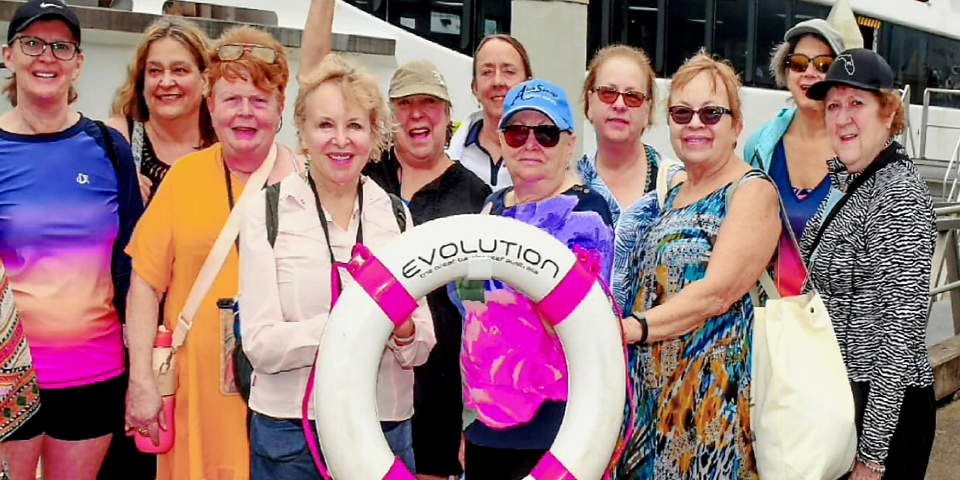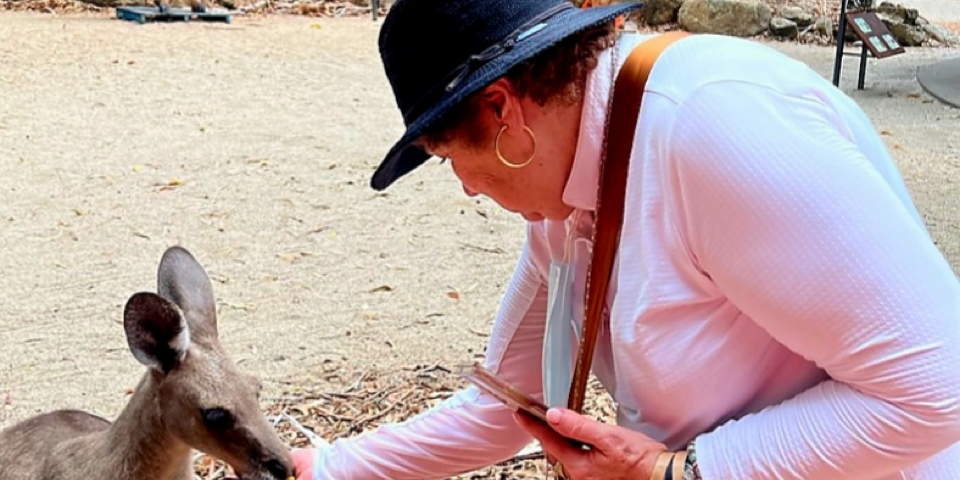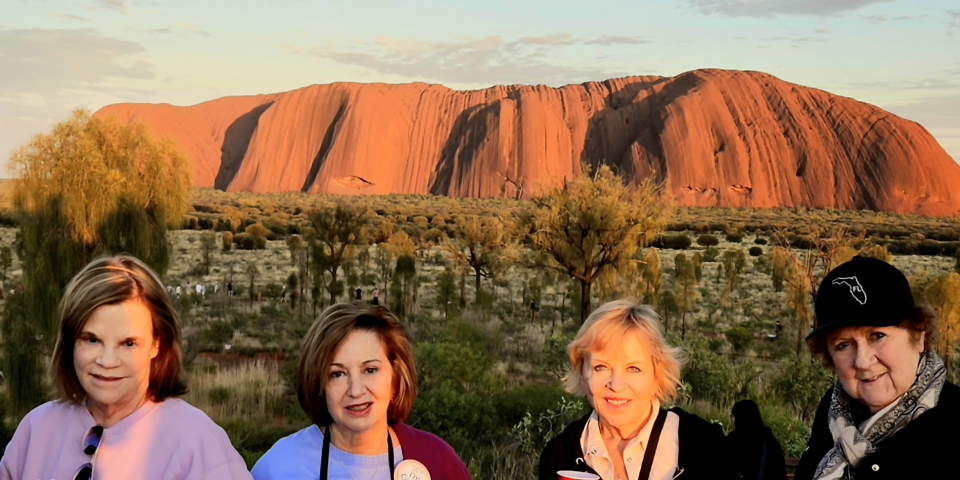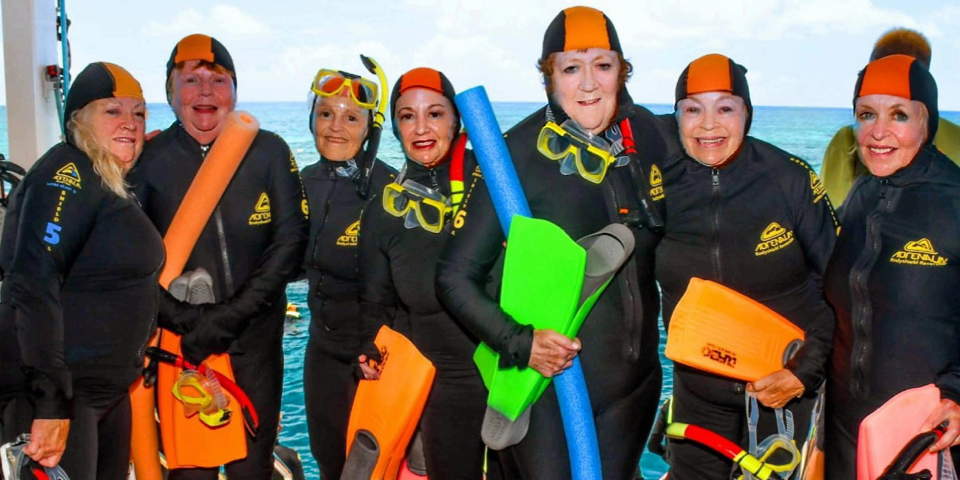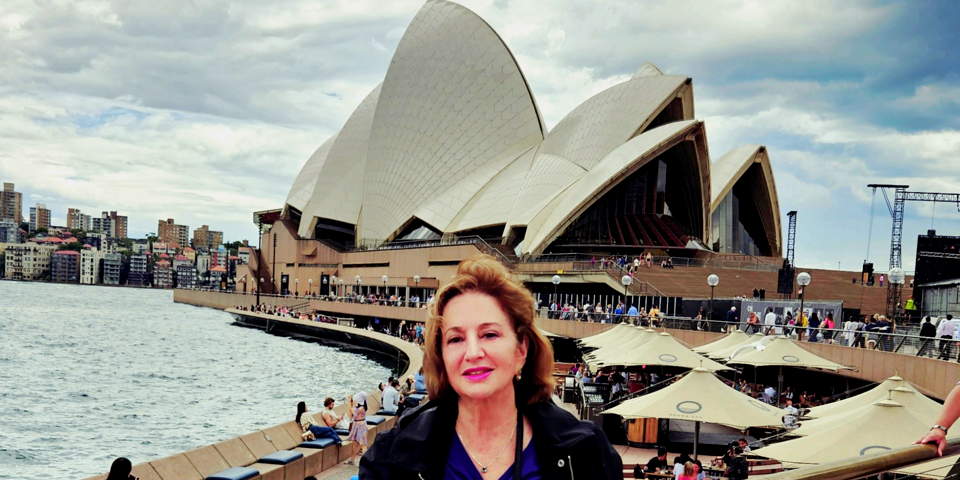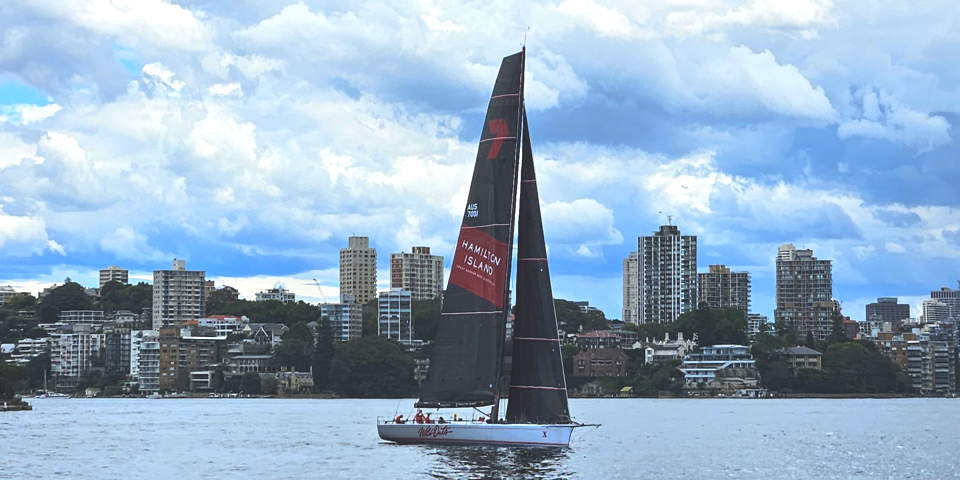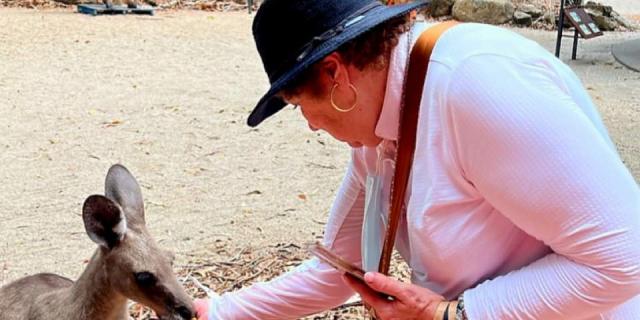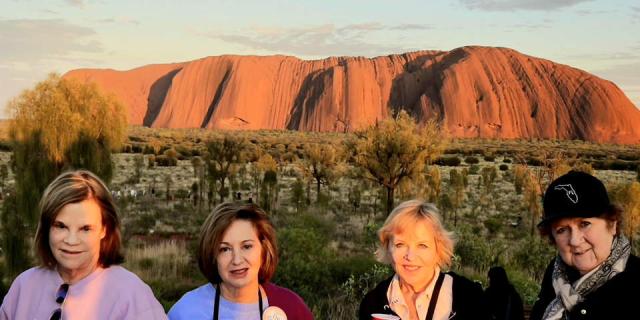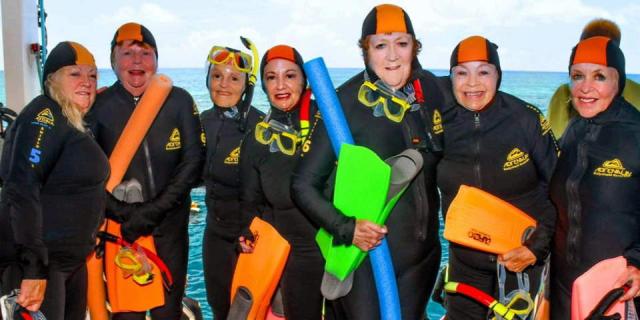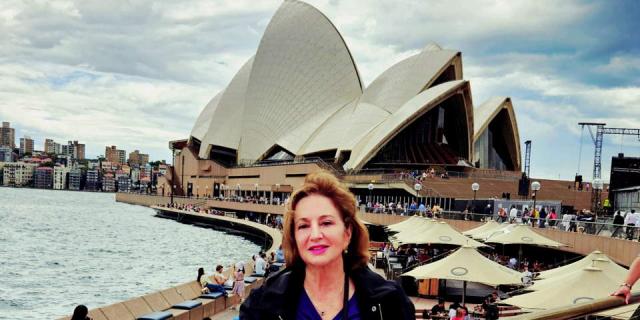- Explore in a small group of 8-16 travelers (average group size of 13)
- All land transportation and 3 internal flights
- Accommodations for 14 nights
- 29 meals—14 breakfasts, 7 lunches, and 8 dinners
- 17 small group activities
- Services of a local O.A.T. Trip Experience Leader
- Gratuities for local guides, drivers, and luggage porters
- 5% Frequent Traveler Credit toward your next adventure
Travel to Australia to uncover some of the continent's best-kept secrets, unparalleled beauty, and cultural allure. Our small group will get an intimate glimpse of how Aussies and the indigenous people come together to weave an inviting and culturally-rich fabric of life. Meet Australia's original residents to understand the controversial history that still affects the indigenous people, and discover how this group is maintaining ancient traditions while adapting to modern day customs. And, let local Aussies share their laidback lifestyle and daily lives with you as you explore their big cities and small towns.
Equally as diverse as the local culture is Australia's contrasting landscapes. Explore Daintree Rainforest's ecological wonderland, snorkel or swim among schools of colorful fish at the Great Barrier Reef, explore the caves and waterholes of Uluru (Ayers Rock), and feel the pulse of Australia's cultural centers—from Melbourne to Sydney. Plus, spend an additional day in Melbourne to experience Mornington Peninsula, where you'll visit a wildlife sanctuary and a local farm, and enjoy an extra day exploring Uluru's massive monolith. Join us on our Ultimate Australia adventure to truly discover the Land Down Under.
And whenever you’d like, you have the freedom to explore more of Australia on your own: Break off from the group for independent discoveries—like venturing to St. Kilda, located near Melbourne, to see penguins on the beach—during free time.
DAY 1
Depart U.S.
Fly from the U.S. to Melbourne, Australia.
DAY 2
Cross International Date Line
You continue your flight from Los Angeles to Melbourne, losing one day en route as you cross the International Date Line. You regain this day when you fly back to the U.S. at the end of the trip.
DAY 3
Arrive in Melbourne, Australia
Destination: Melbourne
Accommodations: Somerset on Elizabeth Hotel or similar
Morning: You’ll arrive in Melbourne this morning to begin your Australia adventure. An O.A.T. representative will greet you at the airport and assist with your 30-minute transfer to our hotel.
Around 10am, we’ll check in at our centrally-located hotel where you’ll have about 5.5 hours of free time to settle in and perhaps begin exploring Melbourne. Depending on where we stay, our hotel may feature a gym, pool, and sauna. Typically, our hotel’s air-conditioned rooms feature coffee- and tea-making facilities, cable TV, and a private bathroom.
Lunch: On your own upon arrival at the hotel. You may choose to set off to find a local restaurant that serves regional specialties like emu or balmain bugs—which are similar to lobsters.
Afternoon: With help from our regional office, we have planned a more leisurely day today to give you time to rest after the long flight here and before we begin exploring the city tomorrow. To help you adjust to the time difference, we spend four nights in enticing Melbourne, the capital of Australia's “Garden State” of Victoria, to give you plenty of time to recharge and truly enjoy the city. You'll have the first day free here. You can relax and make use of the hotel’s amenities, visit local shops, or find your own ways to interact with the locals, who are not known for being shy.
Around 3:30pm, we’ll gather for a Welcome Briefing with our Trip Experience Leader and travelers who chose to take our Undiscovered Tasmania: Hobart, Cradle Mountain & Launceston and New! Adelaide & Kangaroo Island: Australian Culture, Charm & Wildlife pre-trip extensions. During this 1-hour briefing, we will introduce ourselves and review our itinerary in more detail (including any changes that may need to occur). Our Trip Experience Leader will also discuss logistics, safety and emergency procedures, and answer any questions we may have.
Then at about 5pm, we'll set off on a 30-minute orientation walk. At this time, our Trip Experience Leader will explain the tram network and point out ATMs, the grocery store, and other helpful locations near the hotel.
Dinner: On your own tonight. Perhaps you'll try one of the restaurants your Trip Experience Leader pointed out on your orientation walk.
Evening: Your evening is free to rest and relax before our explorations begin tomorrow.
Freedom to Explore
Make the most of your explorations in Melbourne on these off-the-beaten path activities. These recommendations are designed by our team of local experts with women travelers in mind.
Take a walk to Queen Victoria Market with your Trip Experience Leader: Peruse the bustling food and gift stalls of the largest open air market in the Southern Hemisphere. With over 17 acres of produce, souvenir, food, and gift stalls to discover, you may also want to consider a special 2-hour foodie tour to really delve into the history and culture of this iconic market—as well as sample an array of its most popular food options.
How to get there: A 10- to 15-minute walk with your Trip Experience Leader or a 5-minute taxi ride, about $12 USD one way.
Hours: 9:30am-5pm, Thursday-Sunday & Tuesday.
Cost: Free. The optional 2-hour market tour is $69 USD per person
See the penguins at St. Kilda: Witness the sunset roosting ritual of the Little Penguins, the world’s smallest penguin breed, which can only be found in Australia and New Zealand. Travel like a local and board Melbourne's tram in the Central Business District and journey to the historic St. Kilda pier and breakwater. Here, penguins can be seen every night of the year. Whether their molting, feeding their chicks, or mating, you can catch a glimpse of these furry friends, but from a safe distance—viewing platforms and barriers have been installed to protect the penguins. These penguins are quite shy, so they enjoy moving about at nighttime and cannot be seen during daylight hours.
How to get there: A 30- to 40-minute tram ride, about $4 USD one way.
Hours: Daily, beginning at sunset.
Cost: Free.
Discover the Melbourne Museum, a natural and cultural history museum located in the Carlton Gardens in Melbourne—adjacent to the Royal Exhibition Building, The largest museum in the Southern Hemisphere, the Melbourne Museum is also ranked as one of Australia's most popular attractions and is a place where education and history come together in a contemporary setting, It is also home to the Bunjilaka Aboriginal Cultural Centre—a major exhibition that celebrates the history, culture, achievements and survival of Victoria’s indigenous people.
How to get there: A 10-minute taxi ride, about $12 USD one way.
Hours: 10am-5pm, daily.
Cost: $12 USD per person.
DAY 4
Explore Melbourne • Local interaction
Destination: Melbourne
Meals included: B L D
Accommodations: Somerset on Elizabeth Hotel or similar
Activity Note: While riding the trams today, please remember to use caution when getting on and off the cars. They are a unique way to see the city, but mind the steps, which can be steep or difficult for some travelers to navigate.
Breakfast: Served à la carte with traditional Australian options at a local café next to the hotel beginning at 6:30am, featuring hot and cold dishes.
Morning: After yesterday's leisurely start, we set off on foot around 8:45am to explore Melbourne's highlights. Around 9:15am, we’ll start our city tour at the State Library. Then, we'll board the local tram system around 9:30am and ride about 10 minutes to our next stop: St. Patrick's Cathedral. We'll view the intricate stained glass windows and strong, Gothic architecture before continuing on to the Parliament Building. Then, we'll stroll down streets covered in elaborate street murals and meander down narrow laneways and get a true feel for the pulse of the city. Our exploration will then bring us to the neo-Gothic St. Paul’s Cathedral and Flinders Street Railway Station—Australia’s oldest train station—followed by visits to the expansive Federation Square, the cobbled bluestone alley of Degrave Steet, and finally ending at the bar and shop-lined street of Hardware Lane. We'll pause here for lunch.
Lunch: Around 12:30pm at a local restaurant, featuring traditional Australian cuisine.
Afternoon: Following lunch around 1:30pm, we'll depart the restaurant by coach and drive about 15 minutes to the Royal Botanic Gardens. Here, we'll first participate in a walking tour and traditional smoking ceremony that will last around one hour. This tradition is an indigenous custom in which plants are burned to pay respect to the people’s ancestors and the land. Following the ceremony, an indigenous guide will lead us through the 19th-century English garden of more than 8,500 flora species, including cacti, roses, and a variety of herbs. Then, we will sit down with our guide to discuss challenges facing the local indigenous community today. Afterwards around 3:45pm, we'll board our coach and drive about 10 minutes back to the hotel.
Upon arrival to the hotel, you will have about 2 hours of free time. You are free to explore the city further on your own. Melbourne is a city of broad boulevards, green parks, and Victorian architecture, whose growth in the late 19th century was fueled by a gold rush. Public trams running on rails criss-cross the city, as distinctive a symbol of Melbourne as cable cars are of San Francisco. We'll regroup at the hotel around 5:45pm and walk about 15 minutes to a local restaurant.
Dinner: Around 6pm, we'll enjoy a Welcome Dinner at a local restaurant. This is a great chance for you to mingle with your travel companions while savoring a traditional meal.
Evening: We'll return to the hotel around 8pm. The remainder of the evening is free for your own discoveries. You can take some time for yourself, explore the surrounding area, or meet up with fellow travelers to discuss the day.
DAY 5
Melbourne • Local farm visit
Destination: Melbourne
Meals included: B L
Accommodations: Somerset on Elizabeth Hotel or similar
Breakfast: Served à la carte with traditional Australian options at a local café next to the hotel beginning at 6:30am, featuring hot and cold dishes.
Morning: We'll depart the hotel around 8:45am and head by coach to the Mornington Peninsula to visit a wildlife sanctuary. We arrive around 10am, and we’ll have about 1.5 hours here to learn about the conservation efforts being made. We'll also see the country's array of native wildlife, including koalas and kangaroos.
Around 11:30am, we’ll leave the sanctuary and journey by coach for about 15 minutes to a local farm. A local farmer will greet us and lead us on a brief tour of the farmhouse, which will give us an unique glimpse of rural life and offer an opportunity to discuss their daily routines.
Lunch: Around noon at the farmhouse. Our lunch will feature sandwiches and traditional Aussie meat pies.
Afternoon: At about 12:45pm, we’ll drive about 15 minutes to the tip of the Mornington Peninsula on our coach, where you'll be able to view the vibrant, rainbow-colored bathing boxes that for locals have become tightly-held heirlooms passed down through generations and are still in very high demand. While here, we'll also be able to take in sweeping views of the Australian coast. We'll spend about 45 minutes exploring before boarding our coach around 1:45pm and driving back to our hotel.
Upon arrival around 3pm, you’ll have the rest of the afternoon to explore on your own. You may venture to the coastal neighborhood of St. Kilda, known for its scenic beach, promenade, parks, and garden. Take a boat ride on the Yarra River from Princes Walk, or hop on a tram to the suburb of Fitzroy and stroll along lively Brunswick Street with local artists and musicians. Cross the Yarra to Southbank to shop and dine.
Dinner: On your own—you may choose to venture out into the city in search of a traditional meal. Ask your Trip Experience Leader about the city’s classic Aussie fare, such as meat pies, to try on your own tonight.
Evening: On your own to make independent discoveries. If you choose to explore St. Kilda this evening, you may spot penguins waddling along the shores. Or, you may choose to retire to your room to rest before tomorrow’s early start.
DAY 6
Explore Melbourne
Destination: Melbourne
Meals included: B D
Accommodations: Somerset on Elizabeth Hotel or similar
Breakfast: Served à la carte with traditional Australian options at a local café next to the hotel beginning at 6:30am, featuring hot and cold dishes.
Morning: During our additional day in Melbourne enjoy free time to make your own independent discoveries. Perhaps you'll venture to Dendy Street Beach in Brighton to soak up the sun and see some more colorful bathing boxes that line the shore. You can also choose to visit Chapel Street precinct where you can shop for souvenirs, snack on local treats like Lamington—a popular Australian cake made with chocolate, jam, and coconut flakes—or you may even just stroll around the area.
Lunch: On your own whenever you’d like. Your Trip Experience Leader can recommend some of their favorite options for lunch. You may want to search for an Aussie-style hamburger, which is similar to a western-style burger except locals add beetroots as a topping.
Afternoon: You’ll have the afternoon to yourself to explore at your own pace. Perhaps you’ll take the opportunity to shop, visit another museum, or simply stroll through the city. Around 6pm, we’ll gather and board a tram that will drive us about 10 minutes to our dinner location.
Dinner: Served at a local restaurant around 6:30pm, featuring your choice of hot and cold appetizers, entrees, and desserts.
Evening: We'll board the tram again around 8pm and ride back to the hotel, arriving around 8:15pm. The remainder of the evening is free. Ask your Trip Experience Leader for recommendations if you’d like to experience this city at night.
DAY 7
Fly to Alice Springs • Controversial Topic: Forced cultural assimilation of indigenous children with Kumalie Riley • Visit Old Telegraph Station
Destination: Alice Springs
Meals included: B L
Accommodations: DoubleTree by Hilton Hotel Alice Springs or similar
Exclusive O.A.T. Activity: Today’s activities include a conversation with a indigenous Australian elder, Kumalie Riley, about a Controversial Topic: Australia’s decades-long forced assimilation policy, which removed indigenous children from their homes and stripped them of their culture. Although the policy ended in the 1970s, it has had a lasting impact on the health and prosperity of indigenous communities. Read more about this conversation below.
Activity Note: As we journey into the Australian Outback, be prepared for extreme temperatures, which can exceed 100°F during the day and drop dramatically at night.
Breakfast: A continental breakfast will be served at a local café next to the hotel beginning at 6:30am, featuring hot and cold dishes.
Morning: Around 7:30am, we’ll board our coach for the 1-hour transfer to the airport where we’ll catch a nearly 3-hour flight to Alice Springs, located in the Outback. As we fly over Australia’s “red centre,” we’ll see a sprinkling of remote towns, and an arid expanse of red dirt and desert flora from above. A visit here is truly memorable, and during our time in the Outback, our local Trip Experience Leader will provide their expertise on the region to help us see how the geography and culture differ from that of Australia’s big cities.
We arrive around 11am and dive right into our Outback discoveries with a visit to Anzac Hill, a memorial for all Australians who have fought in wars. Offering panoramic views of Alice Springs, we’ll get a bird’s-eye view of the small town and rocky, desert landscape. We’ll spend about 15 minutes here before we board our bus and drive 15 minutes to Alice Springs’s old Telegraph Station, where we’ll enjoy lunch.
Lunch: Around 12:15pm at a café at the Telegraph Station, featuring a selection of sandwiches, coffee, desserts, and other café staples that are made daily on-site.
Afternoon: Afterwards at about 1pm, we’ll enjoy a 30-minute tour of the Telegraph Station. The station marks the European settlement of Alice Springs at the inception of the Overland Telegraph Line, which was established in 1872 to relay messages between Adelaide and Darwin. During our visit, we’ll learn more about the founding of Alice Springs and about the early telegraphers who settled in this rugged region.
After our tour concludes around 1:45pm, we’ll board our motorcoach and drive approximately 15 minutes to Tinkerbee Center, the premier indigenous art and culture center in Alice Springs. This will be our opportunity to learn about Alice Springs’ earliest, non-European inhabitants—and about the discrimination they’ve faced for decades.
Upon arrival, we’ll meet Kumalie Riley—an indigenous elder, artist, and the owner of Tinkerbee Center—who will lead today’s conversation about a Controversial Topic: Australia’s 60-year-long forced assimilation policy that removed indigenous children from their homes, isolated them from their culture, and left lasting scars on the country’s indigenous population.
Kumalie, who is in her 70s, was fortunately not a victim of this forced assimilation. She is, however, old enough to remember it and wise enough to understand how deeply traumatizing it was to her fellow indigenous Australians. Kumalie is passionate about her culture and attempts to keep indigenous traditions alive not only at Tinkerbee Center, but also by teaching her native Arrernte language to both children and adults. However, her greatest achievement may be her involvement in Central Australia’s Grandmother’s Club, a group of eight indigenous grandmothers who tirelessly advocate for survivors of forced assimilation and selflessly support future generations.
Between 1910 and the early 1970s, an estimated 100,000 indigenous children were taken from their parents and either institutionalized or re-homed with white families at the behest of the Australian government. The children often had their names changed, were forced to stop speaking their native languages, and were required to adopt white culture. Nearly 8% of male children and 17% of female children are believed to have been subjected to sexual abuse.
The children affected by these policies are known as the Stolen Generations—and a vast majority suffer from lifelong trauma. The education provided to the stolen children was poor, they often received minimal affection and harsh punishments, and they were rarely given any information about their biological families. Because of their race, the children were never fully accepted by white Australians, and because their cultural identity had been stripped from them, they could no longer relate to their indigenous peers.
Unfortunately, that trauma spread through indigenous communities like a virus. Parents of stolen children routinely turned to alcohol to cope with their losses, and some even resorted to suicide. Descendants of the Stolen Generations, meanwhile, often grow up with parents who are anxious and depressed and never learned healthy parenting skills.
Today, 28% of indigenous children are born to teenage mothers, and 20% of indigenous teens don’t live with either of their parents. Indigenous children are 15 times more likely than white Australians to end up in juvenile detention or under community supervision, and 58% of incarcerated young adults are of indigenous descent.
In 1997, the Australian government released a report titled Bringing Them Home, which detailed the extent of the forced assimilation policies for the first time and included recommendations for reconciliation. The government has been slow to act on those recommendations, however, and did not issue a formal apology to the victims until 2008. Kumalie and other advocates fear that the government is not doing enough to bridge the gap between indigenous and non-indigenous Australians, which could lead to further erosion of indigenous communities.
Kumalie will spend approximately 20 minutes detailing her experiences with victims of the Stolen Generations, and then we’ll have about 40 minutes to ask any questions we might have.
We’ll bid farewell to Kumalie around 3pm and drive approximately 15 minutes to our hotel in Alice Springs. Upon arrival, we’ll check in and receive our room assignments. The hotel’s air-conditioned rooms typically have a balcony, refrigerator, minibar, and private bath. Depending on which hotel we stay at, amenities may include a 24-hour fitness center, pool, sauna, tennis court, and three on-site eateries.
Enjoy the rest of the afternoon to get settled in at the hotel or explore the town as you wish. You may choose to visit the National Pioneer Women’s Hall of Fame where you can trace the history of women’s roles in Australia. We will reconvene around 5pm in the hotel for a 1-hour lesson on how to play the didgeridoo, an indigenous musical wind instrument, with a local musician. The first didgeridoos, played by indigenous people in northern Australia thousands of years ago, were made from fallen eucalyptus branches that had been naturally hollowed out by termites. Today, these instruments are typically made of eucalyptus, bamboo, or agave. During this lesson, we will learn about the differences in contemporary and traditional sounds and techniques. The lesson will end at 6pm, where you have the remainder of the evening free for your own discoveries.
Dinner: On your own around 6pm—you may try one of the hotel’s restaurants or venture into the town center for a local dining experience. Ask your Trip Experience Leader for suggestions.
Evening: You’ll continue enjoying your free time into the evening. Perhaps you’ll take a dip in the hotel pool or enjoy a drink with your small group.
Freedom to Explore
Make the most of your explorations in Alice Springs on these off-the-beaten path activities. These recommendations are designed by our team of local experts with women travelers in mind.
Take a taxi with your Trip Experience Leader to the Todd Mall Markets: Stroll past the various stalls in Alice Spring’s outdoor Todd Mall Market, featuring Aboriginal crafts and art galleries, local food, hand-made jewelry, well-being products, and more.
How to get there: A taxi ride with your Trip Experience Leader.
Hours: March to May from 9am to 1pm, June to August from 9am to 2pm, September to December from 9am to 1pm—daily.
Cost: Free.
Admire art at the not-for-profit organization Araluen Arts Centre – Central Craft: Peruse the work of the center’s craft artists in a broad range of disciplines, which include ceramics, woodwork, weaving, jewelry, silk painting, and more. This organization provides advocacy and support, promotion, professional development, and access to studios for these craftspeople. Visitors can explore the Retail Outlet, Gallery, and the artists' studios.
How to get there: A 10- to 15-minute taxi ride, about $16 USD one way.
Hours: 10am-4pm on Monday-Friday; 11am-3pm on Saturday-Sunday.
Cost: Free.
Visit the original Royal Flying Doctor Service base in Alice Springs, now an interactive museum: Founded in 1939, the Royal Flying Doctor Service is an important, non-profit organization that provides critical care to people living in the isolated regions of the Outback. Learn about the Flying Doctors’ history as well as its devoted team of pilots, engineers, doctors, and nurses—and the experiences of the patients that have benefited from this unique service.
How to get there: A taxi ride from the hotel.
Hours: Monday-Saturday from 9:30am-2:30pm; public holidays 1pm-4:30pm.
Cost: Around $14 USD
DAY 8
Alice Springs • Explore Simpsons Gap & Standley Chasm • Outback barbecue on a family ranch
Destination: Alice Springs
Meals included: B D
Accommodations: DoubleTree by Hilton Hotel Alice Springs or similar
Breakfast: Served buffet-style at the hotel beginning at 6am, featuring hot plates and cold options like yogurt and granola.
Morning: Around 8:30am, we depart the hotel by coach to drive 30 minutes into the deep Australian Outback. Our first stop, around 9am, brings us to Simpsons Gap, one of the most prominent gaps piercing the West MacDonnell Mountain Range. We will have about an hour to explore this scenic area, where towering red cliffs surrender to an open waterhole, and rust-hued walking paths lead us through large stands of mulga trees and witchetty bushes.
During our visit, we have a discussion with a local indigenous man about the cultural significance this gap has within his community. He will also introduce us to the concept of “Dreamtime” storytelling, as well as the system of “skin groups,” which determines who native Australians can marry. In a group as small as ours, this is a great opportunity to ask questions, and come away from the discussion with an in-depth understanding of this region’s history and culture.
We will board our coach again around 10am to set off for a 1.25-hour transfer to Standley Chasm—a geological formation that has long been associated with native women’s culture. Traditionally, only women were allowed to visit the chasm, where they would collect bush medicines and perform sacred rites. A 10-minute walk will bring us to the dramatic, 262-foot face of the chasm. Along the way, our Trip Experience Leader will explain the cultural significance of this site. Interpretive signage is also available along the path if you would like to read more details.
Lunch: On your own around 11:15pm at the nearby Standley Chasm café.
Afternoon: After lunch around noon, we will board our coach and make the 1-hour drive back to our hotel. Upon arrival, you will have a few hours to rest or explore more of Alice Springs on your own.
We will reconvene in the hotel a little over an hour before sunset—this will vary given the time of year. Your Trip Experience Leader will confirm with our small group what time to meet this afternoon. We will be picked up from the hotel by our hosts, Denise and Geoff Purdie, and driven to their ranch for dinner.
Denise and Geoff have owned the 260-acre bushland ranch since 1990. Though the property is located just 15 minutes from Alice Springs, it is completely independent of the town, with its own water supply and solar panels for energy.
Denise moved to Alice Springs with her family in 1965; Geoff arrived five years later for a temporary visit—and never left. Together, they raised two children in this remote territory and developed a deep appreciation for its beauty. For the past 20 years, Geoff has been conducting video interviews with long-time residents of Central Australia in an effort to preserve its history and traditions—and he and his wife will be eager to share that culture with us during our visit. They will help us spot wildlife, like the kangaroo, in the Outback. Then, we will be shown how to throw a traditional boomerang, and perhaps you will even try your hand at this authentic skill.
As the sun begins to set, we will help prepare dinner alongside our hosts. One of the things we will learn to make is damper, a traditional Australian bread that is typically baked in the ashes of a fire. Our hosts will tell us more about the history of this bread and how it originated from Australia’s bushpeople, called swagmen.
Dinner: We’ll enjoy an authentic Australian barbecue with our hosts around dusk. Lamb chops, beef steak, and sausages are traditional barbecue fare, though the food we consume will depend on what’s in season and locally available, as the Purdies grow much of their ingredients themselves.
As we dine, we’ll have the opportunity to ask our hosts any questions we may have—a luxury made possible by our small group size. Perhaps you’ll inquire about the challenges of living in the Outback, or ask what daily life is like on the ranch. Since Alice Springs is the heart of Australia’s indigenous community, you may wish to ask the Purdies for their opinions on the forced assimilation topic we discussed yesterday.
Evening: After our meal concludes, we’ll have some time to continue our conversation around the firepit. Be sure to look up—the Outback is one of the best places in the world for stargazing. We’ll bid farewell to our hosts around 8:15pm and return to our hotel. The remainder of the evening is yours to do as you please, whether that’s gathering with fellow travelers at the hotel or preparing for our flight tomorrow.
DAY 9
Alice Springs • Overland to Uluru (Ayers Rock) • Sunset Viewing
Destination: Yulara/Ayers Rock
Meals included: B L
Accommodations: Desert Gardens Hotel or similar
Activity Note: Our drive to Yulara will take approximately 7.5 hours, with stops included along the way.
Breakfast: Served buffet-style at the hotel beginning at 6am, featuring hot plates and cold options like yogurt and granola.
Morning: Around 7:30am, we'll check out of our hotel, board a motorcoach, and begin our journey to Uluru (Ayers Rock). Our transfer today will take approximately 7.5 hours, with stops included along the way. We will make three brief stops this morning, one around 8:30am, one around 10:15am, and the last around 12:30pm. Each stop will allow us to stretch our legs and take in up-close views of the Outback terrain. Following our third stop, we will drive about 15 minutes to our lunch spot.
Lunch: Around 1pm at a local working cattle station in the Outback, featuring traditional cuisine.
Afternoon: We'll continue driving around 2pm, arriving an hour later in the small town of Yulara, just a short drive from Uluru National Park. This accommodation reflects sensitivity toward the environment with its landscaped desert setting and may offer a swimming pool, restaurant, and bar. Each air-conditioned room may feature coffee- and tea-making facilities, in addition to a refrigerator, minibar, and private bath. You'll have about 1.5 hours to settle in before we gather around 4:45pm to embark on a 30-minute guided walk on the trails in Uluru National Park. Around 5:30pm, we'll pause at a panoramic vista for a traditional sunset toast as the last daylight paints the massive monolith of Uluru into a kaleidoscope of colors.
Early European settlers named it Ayers Rock, but it is called Uluru by the Anangu indigenous people who serve as its spiritual caretakers. In spite of—perhaps even in defiance of—the negative effects of European settlement, some 50,000 years of Australian indigenous culture and spirit have strongly endured in art, dance, and music. Uluru is the most fitting symbol of that endurance.
Watching the sun as it sets on Uluru, it's vividly clear just why the local Anangu people attach paramount spiritual significance to it. As the Outback sun descends on the monolith (whose red/orange hue shifts fluidly throughout the day) the rock seems to glow eerily, as if lit from within. It's almost impossible not to feel the ancient spirit of Uluru. A mystical life force? Perhaps. But the Anangu also consider Uluru a literal giver of life, attracting animals in abundance to its waterhole and providing shelter and firewood to visitors. All in a rugged place one might freely describe as "the middle of nowhere."
After our four days in the Northern Territory, we'll surely have a more profound appreciation for a heritage that runs deep in this land and all of Australia. During our explorations, our local expert guide will put things into perspective and help us understand the connection the indigenous people have to this sacred site. Much of the area around Uluru is open for public visitation, but parts of this site are still so important to the Anangu that they remain off-limits.
We'll depart by coach around 7:30pm and head about 30 minutes back to our hotel.
Dinner: On your own—you may choose to grab dinner at the hotel’s restaurant with your fellow travelers to discuss your discoveries thus far and the explorations to come.
Evening: Your evening is free to walk the hotel grounds or take advantage of its amenities.
Freedom to Explore
Make the most of your explorations in Yulara on these off-the-beaten path activities. These recommendations are designed by our team of local experts with women travelers in mind.
Walk to the Gallery of Central Australia with your Trip Experience Leader: During your visit to the Gallery of Central Australia, you’ll have the opportunity to view authentic Aboriginal artwork, learn about each piece’s cultural significance, and witness artists in residents at work. While admission is free, the gallery has authentic pieces of art available for sale, and each purchase supports the local artists and their families who live and work in the Central Desert region.
How to get there: Walk with your Trip Experience Leader.
Hours: 9am-5pm, daily.
Cost: Free.
Paint like a local at the Maruku Arts Dot-Painting Workshop: Join local indigenous artists and learn about the meaning behind their dot-paintings and how the traditional symbols depict Tjukurpa, or creation stories. Then, under the expert guidance of an indigenous artist, it’ll be your turn to create your own painting to take home as a memento. Perhaps you'll share with your family and friends at home all you have learned about indigenous creation stories through the symbols on your painting.
How to get there: A 5- to 10-minute free shuttle ride.
Hours: Morning and afternoon sessions offered daily. Reservations are needed to take a class.
Cost: About $53 USD.
Ride a camel through the Outback: See the Outback from another perspective—on the back of a camel. You’ll ride through the red dunes and craggy peaks of Uluru National Park just as the early settlers did. Imported in the 19th century, camels remained the primary means of transport until roads and railways were introduced. An estimated 200,000 camels still exist in the Australian Outback today, where only a few are used to explore the desert. So, Saddle up and discover the wonders of the Outback high up atop a camel.
How to get there: A 25- to 30-minute drive to the National Park; the transfer is included in the tour price.
Hours: Morning and afternoon tours offered daily. Reservations are required.
Cost: About $58 USD.
DAY 10
Walk around Uluru
Destination: Port Douglas
Meals included: B D
Accommodations: Desert Gardens Hotel or similar
Early Morning: If you wish, you can rise early this morning to revisit Uluru in the light of dawn, which is as dramatic as the views during sunset but seen by far fewer travelers. Timing of this activity will vary depending on sunrise.
Breakfast: Served buffet-style at the hotel beginning at 6am, featuring hot and cold dishes.
Morning: Around 9am, we’ll continue exploring Uluru during a 3.5-hour walking tour. Our small group will walk around the area, as well as near the base of the massive sandstone monolith where our local expert guide will point out the effects of millions of years of erosion by rain and wind. Uluru is the centerpiece of Uluru-Kata Tjuta National Park, which also includes the spectacular rock formations nearby called the Kata Tjuta. Our local guide will give us more insight into the spiritual symbolism of this natural wonder and the history of the indigenous people's rights to the land. Around 12:30pm, we'll depart the park and drive by bus about 30 minutes back to our hotel. You'll have the remainder of the day free for your own discoveries.
Lunch: On your own—perhaps you’ll choose to eat at the hotel’s restaurant. Or, you may choose to seek out traditional bush food at a local restaurant.
Afternoon: The rest of the day is free for you to explore on your own. Perhaps you'll visit the Wintjiri Museum to see artwork displays created by Australia's indigenous people, or you may elect to stroll around the gardens that surround our hotel to see the region's native flora.
Dinner: Served at the hotel around 6pm featuring regional specialties.
Evening: On your own—you may choose to retire to your room this evening to rest, or you may choose to grab a cocktail at the hotel’s bar with your fellow travelers.
DAY 11
Fly to Cairns • Transfer overland to Palm Cove
Destination: Palm Cove
Meals included: B D
Accommodations: Peppers Beach Club or similar
Breakfast: Served buffet-style at the hotel from 6am-10am, featuring hot and cold dishes.
Morning: Enjoy the morning free for your own discoveries. Perhaps you'll explore the Outback from a new vantage point—on the back of a camel. Or, maybe you'll learn more about weapons of the bush from a local indigenous storyteller at the Circle of Sand.
Lunch: On your own—you can grab something in town or at the airport while you wait for your flight.
Afternoon: Around 1:45pm, we depart the hotel and drive for 15 minutes to the airport. Upon arrival, we’ll have some time to check in and relax before our 3-hour flight to Cairns, departing around 3:15pm.
When we arrive in Cairns around 6:15pm, we’ll travel for 30 minutes by coach to our hotel in Palm Cove, which is known for its beachfront. Depending on which hotel we stay at, amenities may include a spa, gym, a swimming pool, and a restaurant. Typically, the hotel’s air-conditioned rooms have wireless Internet access, TV, coffee- and tea-making facilities, safe, and a private bathroom. We'll arrive around 7:15pm.
Dinner: Around 7:15pm, we’ll gather in the hotel’s restaurant for a 2-course barbecue dinner.
Evening: You are free to explore Palm Cove on your own this evening, or make use of the hotel’s many amenities. You may choose to retire to your room to rest before our early start tomorrow.
Freedom to Explore
Make the most of your explorations in Palm Cove on these off-the-beaten path activities. These recommendations are designed by our team of local experts with women travelers in mind.
Walk to Palm Cove Beach with your Trip Experience Leader: Experience the serenity of Palm Cove Beach—where the rainforest meets the Great Barrier Reef. This pristine stretch of palm trees and sand beckons locals and visitors alike. From sunbathing and swimming to kayaking and jet skiing, there is an array of activities to please any beach goer.
How to get there: Walk with your Trip Experience Leader.
Hours: Daily.
Cost: Free.
Take a relaxing yoga class: Hartig Yoga offers classes to people of all skill levels. Classes take place in three locations—by the beach, pool, and rooftop. Classes offered can focus on relaxation, invigoration, or strength. But no matter what class you take, you'll be sure to soak in the tropical atmosphere from a unique vantage point.
How to get there: A 5- to 10-minute walk.
Hours: Various times throughout the day. Your Trip Experience Leader can help you schedule a class.
Cost: About $12 USD.
Relax with a spa treatment at Peppers Beach Club: Slow down and take a minute to appreciate your naturally picturesque surroundings with these luxury services.
How to get there: Located in your hotel.
Hours: Daily.
Cost: The spa offers a variety of services at different prices; call front desk for details.
DAY 12
Cruise to the Great Barrier Reef • Grand Circle Foundation visit: Coral Nurture Program
Destination: Palm Cove
Meals included: B L
Accommodations: Peppers Beach Club or similar
Exclusive O.A.T. Activities: Today’s discoveries at the Great Barrier Reef feature an overview of the Coral Nurture Program, a new initiative dedicated to preserving and implementing long-term stewardship of Australia's coral reefs. This initiative is supported in part by Grand Circle Foundation.
Breakfast: Served buffet-style at the hotel beginning at 6:30am, featuring hot and cold dishes.
Morning: We’ll depart the hotel around 7am and set off for our full-day excursion to the Great Barrier Reef. Driving by coach for about 30 minutes, we'll arrive at the marina around 7:30am. Here, we'll be met by a marine biologist who works for the Coral Nurture Program, a Grand Circle Foundation site that is taking a new approach to the problem of coral bleaching at the reef.
As we'll learn throughout our discoveries today, the rising temperature of the world's oceans paired with an increase in tourism to the Great Barrier Reef has caused much of the coral here to lose its color (a process referred to as "bleaching") and even die. The Coral Nurture Program aims to slow this process by promoting community-led stewardship of the reefs and by planting new coral at the reef using innovative, science-backed techniques. The marine biologist we meet with this morning will accompany us throughout our day at the reef, giving us an ongoing commentary on what we see as we cruise. To start off, he or she will show us a coral fragment that was successfully grown at the North Hastings Reef.
Then, around 8:30am, we'll board our catamaran and set sail to the Outer Reef, where this natural wonder is yours to explore. We linger here for most of the day. Possibly the best description of the Great Barrier Reef comes down to five simple words: “the world's largest living thing.” Its nomination for World Heritage status stated, “The Reef supports the most diverse ecosystem known to man ... an ecosystem which has evolved over millions of years.”
But even facts like these can only hint at the sheer immensity and beauty of the Reef. Our first peek, through diving masks or a semi-submersible vessel, will bring into view its striking appearance. We'll witness tropical fish darting about amid sea fans and anemones swaying with the waves. Our marine biologist will be on hand to interpret the wildlife we see, including the tropical fish and giant clams.
There's no one “right” way to explore the Reef, so we'll be given a choice. You can swim or snorkel among the fish and wide array of corals. Or, if you wish to observe this spectacular underwater world without submerging yourself, you can view parts of the Reef from our semi-submersible vessel. However you do it, you are in a prime spot to experience the nature of the largest coral reef in the world.
Later, we'll visit the Coral Nursery Project, a Grand Circle Foundation site.
Grand Circle Foundation
Coral Nurture Program
Partner since: 2021
The Coral Nurture Program is in the process of planting and growing coral to combat the growing issue of coral bleaching in the Great Barrier Reef. The nursery is planted in relatively shallow water (about 18-24 feet in depth), allowing you the chance to observe it from above as you snorkel. Keep your eyes peeled for a special sight: A section of the nursery has been dedicated to Grand Circle Foundation thanks to the generous support of our travelers.
Learn more about the sites we support »
Lunch: Around noon, we’ll enjoy a buffet lunch onboard the catamaran.
Afternoon: We’ll continue our exploration of the Reef until 3pm, when we sail for about 2 hours back to shore. As we cruise, feel free to ask our marine biologist any questions you may have about the Coral Nurture Program's goals, and its progress so far.
Upon arrival to the arena around 5pm, we transfer 30 minutes back to our hotel in Palm Cove.
Dinner: On your own—you may dine at the hotel’s restaurant this evening, or you may choose to venture out in search of a local restaurant that serves traditional dishes, including John Dory fillets, sweet fish fillets usually baked, grilled, or fried.
Evening: After a long day on the water, you may choose to use your evening to relax and refresh—or experience Palm Cove at night with a recommendation from your Trip Experience Leader.
DAY 13
Controversial Topic: Climate change and human interference in the Daintree Rainforest with Angie and Neil Hewett • Guided Rain Forest Walk • Wildlife Cruise
Destination: Palm Cove
Meals included: B L D
Accommodations: Peppers Beach Club or similar
Exclusive O.A.T. Activity: Today’s activities include a conversation about the Controversial Topic of climate change and human interference in the Daintree Rainforest. Our conversation will be led by Angie and Neil Hewett, who live and operate an eco-tourism lodge within the rainforest. Read more about this experience below.
Breakfast: Served buffet-style at the hotel beginning at 6:30am, featuring hot and cold dishes.
Morning: We’ll board our coach around 8am for a 2-hour drive to another Australian natural wonder—the Daintree Rainforest.
We tend to think of the Amazon as the most ancient of all rainforests. But at a mere ten million years old, the Amazon is really a grandchild to the Daintree Rainforest. This Australian national park is a unique ecological gem—it is the only place on Earth where the forests are much as they were 100 million years ago. In a riot of moist greenery much like this, the very first species of flowering plants bloomed while dinosaurs were still alive.
Around 10am, we’ll stop at the Heritage Lodge—a rainforest retreat tucked into Daintree’s ferns and palms—for morning tea. After relaxing in this peaceful environment for approximately 15 minutes, we’ll make our way to Cooper Creek Wilderness, a privately owned, nationally accredited preserve that offers eco-friendly tours of the rainforest’s myriad wonders.
At approximately 10:30am, we’ll begin exploring the rainforest alongside two members of the local family that owns the preserve: Neil and Angie Hewett. They'll share a unique perspective that only locals can provide and they'll point out the diversity of flora to us. Our small group size allows us to enjoy up-close views of the forest's splendors, and we may also spot some of the animals that call the rainforest home, including Rufous owls, spotted cuscus, and sugar gliders.
The rainforest has enjoyed protected status since 1988, thanks to the environmental activists (or “greenies”) who campaigned tirelessly to end logging, clearing, and construction in the area. Unfortunately, however, it is still not immune from the detrimental influences of the industrialized world. As we continue to enjoy the splendor of our surroundings, Neil and Angie will open up around 11am about the Controversial Topic of the impact of climate change and urban development on the Daintree Rainforest.
The Hewetts have been stewards of the rainforest for more than 30 years: Neil, his brother Brian, and their mother, Prue, first began exploring the Daintree Rainforest in the late 1980s. Eventually, their love of the land inspired the family to purchase a 160-acre plot on Cooper Creek, which became not only the family homestead, but also an eco-tourism enterprise. Since 1994, the Hewetts have been sharing their first-hand expertise about the Daintree Rainforest with guests from around the world.
Daintree is like a botanical Jurassic Park, hosting plant species so primitive they scarcely differ from their prehistoric ancestors. The lush, dense landscape is but one component of the Wet Tropics World Heritage Area of Australia. This region comprises just one-thousandth of the continent's land, yet hosts an impressive range of Australia's native species. A full 40% of its plant species can be found here, as well as a quarter of its reptiles, a fifth of its birds, and a third of its marsupials and frogs. An astounding 633 species of plants, mammals, birds, and reptiles are found nowhere else but the Daintree Rainforest, and many are classified as threatened.
While the majority of the rainforest is protected by UNESCO, certain sections of its lowland forests are still privately owned. Some of this land has already been cleared for agricultural purposes, and other sections have been outfitted with infrastructure like roads and electrical transmission lines. This human interference not only fragments natural habitats, but it could also introduce invasive, non-native plant and animal species to the delicate ecosystem.
In addition to the issues posed by human development, climate change is also a major threat to the future of the Daintree Rainforest. Average annual temperatures in Australia have increased twice as quickly in the last 50 years compared to the 50 years before, and heatwaves are becoming more frequent. Annual rainfall has declined by up to 20% in some regions during that same period. As temperatures continue to rise, experts predict a 10-40% habitat loss for tropical species in Victoria and suggest that at least 90 Australian species could be at risk as climate conditions worsen.
The Hewetts will spend approximately 20 minutes sharing their insights into these threats to the Daintree. They’ll also discuss sustainable practices that could help protect the rainforest for future generations. Afterward, we’ll have approximately 40 minutes to ask any questions we may have.
Around noon, we will depart the forest and drive about an hour to a local restaurant.
Lunch: Around 1:15pm in a local restaurant, featuring regional Australian dishes.
Afternoon: At about 2:15pm, we’ll head back by coach to our hotel, arriving around 3:30pm. Enjoy the remainder of the day on our own—perhaps you’ll choose to take a yoga class by the beach.
Dinner: At the hotel around 6:30pm, featuring a three-course set menu as well as coffee and tea.
Evening: The evening is free to continue exploring Palm Cove on your own.
DAY 14
Fly to Sydney
Destination: Sydney
Meals included: B D
Accommodations: Rydges World Square Sydney or similar
Breakfast: Served buffet-style at the hotel from 6:30am-10:30am, featuring hot and cold dishes.
Morning: Enjoy a couple of hours of free time this morning to relax before we drive about 45 minutes to the Cairns airport, arriving around 12:15pm.
Lunch: On your own—consider picking something up in the morning to bring on the flight.
Afternoon: Around 1:30pm, our flight departs for iconic Sydney. We’ll be in the air for about three hours, and as we fly over the city, make sure to glance out the window to see the Opera House, the Sydney Harbour Bridge, and other landmarks from above. During our explorations here, we'll see the city from a couple of different vantage points as we discover Sydney's highlights on foot and during a harbor cruise.
We arrive in Sydney around 4:30pm and transfer about 45 minutes by coach to our hotel. We’ll arrive at our centrally-located hotel around 5:45pm. Depending on which hotel we stay at, amenities may include an indoor pool, and wireless Internet access throughout the hotel. Typically, each air-conditioned room features TV, coffee- and tea-making facilities, and a private bathroom. We’ll have about 45 minutes to settle into our rooms before we enjoy a 15-minute orientation walk with our Trip Experience Leader around 6:15pm. Then, we'll board our bus and drive about 15 minutes to Spice Alley—a vibrant laneway featuring multiple hawker-style eateries.
Dinner: We'll stop at Spice Alley's eateries around 6:30pm, where you'll have the freedom to choose an included dinner of Asian cuisine.
Evening: You have the evening free to get acquainted with this world-famous city. Experience nightlife in Sydney, take a walk around the neighborhood of the hotel, or get a look at the iconic sites after dusk.
Freedom to Explore
Make the most of your explorations in Sydney on these off-the-beaten path activities. These recommendations are designed by our team of local experts with women travelers in mind.
Take a train to Sydney Harbour Bridge with your Trip Experience Leader: Affectionately known as the “coat hanger” by the locals, the Sydney Harbour Bridge offers spectacular views of the city as you cross this famous Australian site via the pedestrian walkway.
How to get there: A train ride with your Trip Experience Leader.
Hours: Daily.
Cost: Free.
Ride the Manly Ferry and see Sydney from the water: Hop aboard the Manly ferry and traverse one of the world’s most scenic harbors as you sail past famous Australian sites such as the Sydney Opera House and Harbour Bridge.
How to get there: A taxi ride from your hotel.
Hours: 30-minute trips, operating daily.
Cost: Around $9 USD.
Savor High Tea at the Tea Room in the Queen Victoria Building: Whether sipping tea or Champagne, the art of the High Tea has been enjoyed since the 1700s. Preserving both the tradition and style, it is celebrated with great pleasure every day here at Sydney’s Queen Victoria Building Tea Room. The Tea Room offers morning tea and traditional afternoon high tea service tea in luxurious surroundings that celebrate the cultural significance of the historic building’s ballroom.
How to get there: A 15-minute walk from the hotel.
Hours: Opens 10am, Monday-Sunday.
Cost: Tea services range from $12 to $32 USD per person.
DAY 15
Tour Sydney Opera House • Sydney Harbour ferry ride • Quarantine Station
Destination: Sydney
Meals included: B L
Accommodations: Rydges World Square Sydney or similar
Play VideoPlay
Mute
Loaded: 0%Progress: 0%
0:00
Fullscreen
Recommended Video : Smart Travels with Rudy Maxa: Sydney
Produced by Small World Productions
Follow Emmy Award winner Rudy Maxa as he sails to scenic beaches, treks into the Blue Mountains, and samples the cuisine of Sydney.
Share This Video
Breakfast: Served buffet-style at the hotel beginning at 6:30am, featuring hot and cold dishes.
Morning: Leaving our hotel by coach around 8am, we head out for a city tour. First, we begin our discoveries around 8:45am with a 1-hour guided tour of the Sydney Opera House, whose distinctive architecture has made it the city's signature attraction. This architectural masterpiece was made a UNESCO World Heritage Site in 2007, and you'll see firsthand why it deserves this title. This visually spectacular performance facility boasts four auditoriums that host symphony concerts and theater as well as opera. Following our visit around 10am, we'll walk to Circular Quay where we'll join locals on a 45-minute ferry ride around Sydney Harbour, taking in striking views of the city skyline as we blend into the perpetual bustle of water-borne activity.
Then, around 11am, we disembark our ferry and begin a 1-hour walking tour of Sydney's North Head Quarantine Station. Led by a local guide, we'll delve into the complicated history of this station. From the 1830s until about 1984, migrant ships arriving into Sydney with suspected contagious diseases stopped at the station and offloaded passengers and crew. This practice, called quarantine (derived from the Italian quaranta giorni meaning forty days), began in 14th-century Venice when ships arriving from infected areas were required to sit at anchor for 40 days before coming to shore. The station now serves as a conference center with accommodations. Our tour will conclude around 12:15pm.
Lunch: Around 12:30pm at the station, featuring modern Australian cuisine.
Afternoon: Following lunch around 2pm, we will board our ferry again and ride about 45 minutes back to Circular Quay. Upon arrival to the quay, you have the remainder of the afternoon to explore on your own. If you wish to return to the hotel, there will be a coach to bring you back around 3pm.
Dinner: Ask your Trip Experience Leader for suggestions or discover for yourself an interesting spot for dinner on your own this evening. Perhaps you'll try pan-fried kangaroo or savor a traditional meat pie.
Evening: You are free this evening to continue exploring on your own, catch up with fellow travelers at the hotel, or take an evening to yourself to rest.
DAY 16
Explore Sydney
Destination: Sydney
Meals included: B D
Accommodations: Rydges World Square Sydney or similar
Breakfast: Served buffet-style at the hotel beginning at 6:30am, featuring hot and cold dishes.
Morning: Today, conclude your Australia travel experience by exploring Sydney on your own. You can relax, visit local shops, return to the seashore to visit any of the several beaches that are accessible by public transportation, or you may choose to take a tour of Sydney Tower, an enormous structure that stands at around 1,000 feet, to take in panoramic views of the city.
Lunch: On your own whenever you’d like. Ask your Trip Experience Leader to suggest a new or unusual restaurant to try today.
Afternoon: Continue exploring on your own this afternoon. Perhaps you’ll go behind the scenes at the Sydney Fish Market, or explore the Art Gallery of NSW (New South Wales)—a museum dedicated to international and Australian fine art.
Our group will gather at the hotel around 5:30pm and walk 15 minutes to a local restaurant.
Dinner: Around 6pm, we'll say goodbye to Australia over a Farewell Dinner at a local restaurant. Our meal will feature three courses of modern Australian and Italian cuisine and a complimentary glass of wine, beer, or soda as well as a tea or coffee.
Evening: We return to the hotel around 8:30pm. You may choose to retire to your room to pack before your flight home tomorrow, or you may set off to find a local bar where you and your fellow travelers can grab a drink and toast to your discoveries.
DAY 17
Return to U.S. • Begin post-trip extension
Meals included: B
Breakfast: Served buffet-style at the hotel beginning at 6:30am, featuring hot and cold dishes.
Morning: Around 9am, transfer to the airport to catch your flight back home. We’ll arrive at the airport around 9:30am. Or, fly to Auckland or Fiji, if you've chosen to take our New Zealand: Auckland, Queenstown & Milford Sound Cruise or New! Fiji’s Tropical Splendor & Captivating Culture post-trip extensions.
